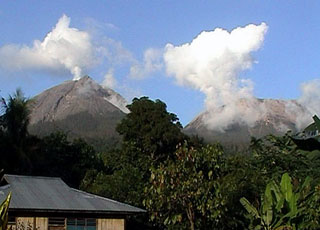Report on Lewotobi (Indonesia) — 14 February-20 February 2024
Smithsonian Institution / US Geological Survey
Weekly Volcanic Activity Report, 14 February-20 February 2024
Managing Editor: Sally Sennert.
Please cite this report as:
Global Volcanism Program, 2024. Report on Lewotobi (Indonesia) (Sennert, S, ed.). Weekly Volcanic Activity Report, 14 February-20 February 2024. Smithsonian Institution and US Geological Survey.
Lewotobi
Indonesia
8.542°S, 122.775°E; summit elev. 1703 m
All times are local (unless otherwise noted)
PVMBG reported that the eruption at Lewotobi’s Laki-laki volcano was ongoing during 13-20 February. The lava flow on the NE flank continued to be active, advancing 100 m during 3-20 February to a total length of 4.2 km. A drone overflight on 20 February confirmed the position of the end of the lava flow. White steam-and-gas plumes were visible during 13, 15, 17, and 19-20 February rising as high as 100 m above the summit and drifting N, NE, and W; no emissions were observed on 14 February. White-and-gray ash plumes rose as high as 600 m above the summit on 16 and 18 February and drifted N and NE. According to a news article, all evacuees had returned to their homes. The Alert Level remained at 3 (the second highest level on a scale of 1-4) and the public was warned to stay outside of the exclusion zone, defined as a 3-km radius around Laki-laki crater, 4 km to the NNE, and 5 km on the NE flanks.
Geological Summary. The Lewotobi edifice in eastern Flores Island is composed of the two adjacent Lewotobi Laki-laki and Lewotobi Perempuan stratovolcanoes (the "husband and wife"). Their summits are less than 2 km apart along a NW-SE line. The conical Laki-laki to the NW has been frequently active during the 19th and 20th centuries, while the taller and broader Perempuan has had observed eruptions in 1921 and 1935. Small lava domes have grown during the 20th century in both of the summit craters, which are open to the north. A prominent cone, Iliwokar, occurs on the E flank of Perampuan.
Sources: Pusat Vulkanologi dan Mitigasi Bencana Geologi (PVMBG, also known as CVGHM), Antara News, Antara News

